
Tile Descriptions
here are four basic faction decks in the game. Each deck consists of 35 tiles which are marked appropriately on their back to indicate which faction they belong to.

Unless otherwise specified, tiles affect all types of Board tiles (Banners, Champions, Runes) when used.
Unlike Order tiles, Board tiles have numerous icons which provide information regarding the characteristics of a particular tile, such as:

Initiative

Most Champion tiles are marked with a symbol indicating its Initiative in the game. The higher the Initiative, the earlier in each Battle a given tile will attack.
The Initiative values printed on the tiles range from 3 to 0. The values indicate the number of the phase in which a tile can perform an attack.
Some tiles have more than one Initiative value printed on them, which means that the tile can attack several times - performing all attacks during each of the indicated phases of Battle.
There are also tiles with no Initiative symbols (for example Runes). These tiles' effects are not restricted to one phase of Battle. A tile with no Initiative symbol affects the other tiles as soon as it is placed on the board, and until it is removed.

Board Tiles
Board tiles, as opposed to Order tiles, are ones that can be placed on the game board. There are 3 types of Board tiles: Banners, Champions, and Runes.
Banners

Each Banner has 20 Hit Points which are reduced through successful enemy attacks. If the number falls to 0, the Banner is destroyed and the faction it belongs to loses the game.
Each faction's Banner has a different special ability which is described on the reference chart of each faction. Please note that the Banner's ability does not affect the Banner itself.
Moreover, each Banner can hit all adjacent enemy Champions and Runes with a Melee Attack with a Strength of I. However, a Banner cannot attack another Banner.
- A Banner can NEVER harm another Banner, regardless of Runes or effects
- Each Banner has an Initiative of 0.
Champions

On the front of Champion tiles, in addition to the illustrations of individual champions, there are symbols defining the abilities of each tile (for example Melee attack, Ranged attack, Armor, or Net) as well as icons representing their Features.
The symbols can be found on one, two, three, or all sides of the tile. The specific symbol indicates an ability working only in the direction of the side the symbol is shown on.
Detailed Description of the Symbols
Melee Attack

This symbol represents a Melee attack performed on an enemy tile adjacent to the edge with the symbol.
If a tile has more than one of these attack symbols, all attacks are performed simultaneously during Battle.

A Melee attack with a strength of 2 in 3 directions
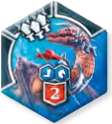
A Melee attack with a strength of 3 in 1 direction.
The number of Melee attack symbols on the same edge (1,2, or 3) determines the Melee attack strength in the given direction (the number of Wounds inflicted).
If a Rune increasing Melee attack strength is connected to the tile, it increases the attack strength in all directions.
Attacks are automatic and the players cannot stop their Champion from attacking.
Example: The Veteran Champion attacks both the Banner of the Human Empire and the Pikeman, inflicting 2 Wounds, and 1 Wound respectively.
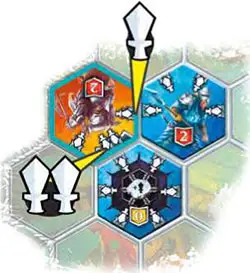
Ranged Attack
Ranged attacks are shots and spells fired during battle. They hit and inflict a Wound to the first enemy tile in the attacker's line of sight, no matter how far the tile is.

A Ranged attack with a strength of 2 in I direction.

A Ranged attack with a strength oft in 4 directions
The symbol on the tile indicates the direction of the attack (in a straight line from the tile edge). If a Champion has two or more Ranged attack symbols, it shoots in all directions simultaneously during the Battle.
The number of Ranged attack symbols on the same edge (1,2, or 3) determines the Ranged attack strength in the given direction (the number of Wounds inflicted).
If a Rune increasing Ranged attack strength is connected to the tile, it increases the attack strength in all directions.
Attacks are automatic and the players cannot stop their Champion from attacking.
Warriors shoot over friendly Board tiles, so no friendly fire is taken into account (it reflects their coordination during the fight). Friendly tiles do not obscure line of sight towards enemy tiles in the same line (attacks go past or over them).
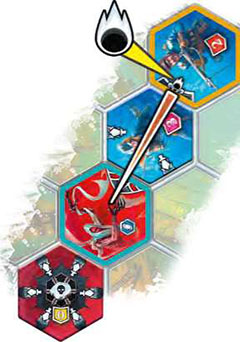
Example: The Dragon Empire Arquebusier shoots towards the tiles of the Lords of the Abyss.
The Ranged attack does not Wound the friendly tile (Empire Swordsman) and flies past.
It hits the Nightmare of the Lords of the Abyss, which is the first enemy tile in the line of attack.
The attack will not reach the Banner, hidden behind the back of the Nightmare Champion.
Armor

Armor protects completely from all strength 1 Ranged attacks and decreases the strength of more powerful Ranged attacks by 1.
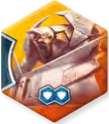
Armor protecting 1 side.
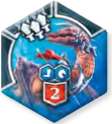
Armor protecting 3 sides
It does not, however, protect from Melee attacks. Note that a Ranged attack from an adjacent hex is still a Ranged attack and not a Melee attack.
The Armor symbol on the tile indicates which side is protected. If an armored tile is attacked from a different direction than the protected side, the Armor has no effect and the attack hits.
Armor does not protect from attacks performed using Order tiles (such as a Precise Shot or Fire Concoction).
Armor protects the tile from the Ranged attacks modified by the Rune of Penetration (possessed by the Guardians of the Realm faction) as usual, but the attack still affects all the other tiles in the line of fire.
Armor protection is automatic, and players cannot choose whether to protect a tile from a Ranged attack.
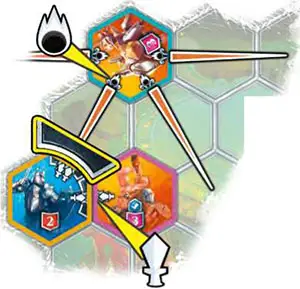
Example: The Knight is attacked by 2 enemy Champions. The Combat Platform attacks with a Ranged attack with a strength oft, from which The Knight is completely protected by the Armor.
The Pupil attacks with a Melee attack strength oft against which the Armor does not protect.
Net

Nets disable adjacent Board tiles, preventing them from moving, attacking, pushing back, adding bonus Features, etc.
Net symbols indicate the directions in which the Nets works. Only the tiles whose edges are adjacent to the Net symbol are disabled.
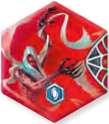
A Networking in I direction.
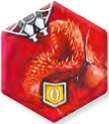
A Networking in 1 direction, and a Melee attack with a strength of 2 in the same direction.
Nets disable the opponents as soon as they are placed on the board, not only during Battle.
 The Net does not affect the Armor and Toughness Feature in any way - the Netted tile is still protected by its Armor and has the additional Hit Point.
The Net does not affect the Armor and Toughness Feature in any way - the Netted tile is still protected by its Armor and has the additional Hit Point.To easily remember which tile is disabled by a Net, the player can place a Net marker on the tile. The player can remove the marker when the tile stops being affected by the Net (if it happens during the Battle, the player removes the marker at the end of the phase during which the tile was freed).
A Net is in effect continuously and players cannot choose to ignore the effect.
Note: Nets also affect enemy Banners.
Description of Features
Descriptions of the most common Features can be found below. Certain Features (Teleport, Cavalry, Transformation, etc). are specific to single factions and are described in detail on their respective faction reference sheets.
Toughness

Board tiles, with the exception of Banners, are eliminated after receiving a single Wound.
Each Toughness icon represents an additional Wound a tile can sustain before being destroyed. Thus, a tile with one Toughness icon must receive at least 2 Wounds before being removed from the board.
A tile with two Toughness icons must receive at least 3 Wounds before being removed from the board.
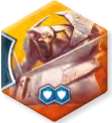
Champion with 2 Toughness Features
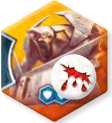
The same Champion after receiving 1 Wound
Each Wound inflicted on a tile that does not remove it from the board (except for the Banners) is marked with a Wound marker placed on the tile.
Maneuver

A tile marked with this symbol can move one hex and/or rotate freely on the board once per turn.
A tile may only be moved onto a free hex. AU movement is carried out on the controlling player's turn, and never during Battles.
A player can move a tile with Maneuver before or after placing his new tiles on the board.
Note: Tiles cannot be moved during a Battle.
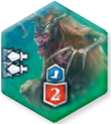
Champion with the Maneuver Feature
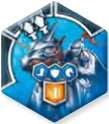
Champion with the Maneuver Feature and two other Features.
Feature Markers
Some of the Board tiles have Features whose influence on other tiles is marked
with additional tokens (Features such as: Net, Venom, or Disarmament) in order to present a clear overview of the situation on the board at a given moment. These markers are placed on the tiles the moment a Feature is activated, or special attack utilizing the Feature is resolved.
They are removed when the tile containing the Feature is eliminated, though certain Feature abilities are removed under different circumstances, of which the details may be found in the Feature description.

Examples of Runes affecting tiles in one direction, two directions, three directions, all directions, and for the entire board.
Runes affect all adjacent tiles connected to them. Rune connection paths printed along the edges show the direction in which they can connect to another tile. In most cases, these are other tiles in a player's own faction.
The influence the Rune has on the tile is depicted as a symbol in the center of the tile.
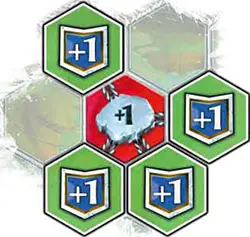
Example: Rune of Minor Acceleration affecting friendly (connected) tiles in four directions.
Rune influence cannot reach a tile indirectly through another tile. For example, a Rune connected to another Rune does not transmit its influence over a longer distance.
Note: Exceptions to this rule are rare Runes with unlimited range, which affect the entire board. They do not have connection paths and the exact description of their ability can be found on their faction reference sheet.
Runes do not affect enemy tiles (unless specified otherwise in their description).
They begin affecting tiles the moment they are connected to them (not only during Battles). Runes are always active and can never be turned off.
A Rune's ability is not an attack and cannot be multiplied by a tile providing an additional attack (such as the Rune of Double Attack from the Lords of the Abyss faction).
Note: Runes can be eliminated like Champion tiles and some of them also have an additional Toughness Feature.
Note: Runes also affect Banners.
Note: In addition to the symbol of an ability affecting the connected tiles, there may be an additional Feature on the Rune tile (Rotation, Toughness, etc).. These Features only affect the Rune tile, not the connected tiles.
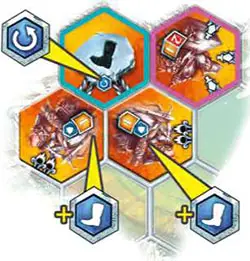
Example: The Guardians' Rune of Agility is connected to two Crossbowman tiles and is adjacent to the Axeman.
The connection allows both Crossbowmen to use the Maneuver Feature provided by the Rune, but the Axeman is not connected to the Rune and cannot use the Feature. Rotation, the Rune's Feature, allows the Rune to rotate (only the Rune).
If after rotation the Axeman is connected to the Rune, it will be able to use the Maneuver Feature this turn.
Runes Common for Most Faction
Rune of Strength and Rune of Accuracy
These Runes increase the strength of a connected friendly tile's Melee or Ranged attack by 1.
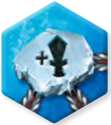
The Rune of Strength increases the strength of Melee attacks by 1 and connects in 3 directions.
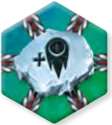
The Rune of Accuracy increases the strength of Ranged attacks by 1 and connects in all directions.
Runes of Acceleration
The Runes of Minor and Greater Acceleration increase the Initiative of friendly connected tiles by 1 and 2, respectively.
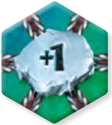
Rune of Minor Acceleration that connects in all directions.
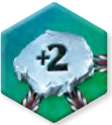
Rune of Greater Acceleration that connects in 3 directions.
To make it easier to remember which tiles have an increased Initiative, the player may place a marker with the updated Initiative on these tiles, with the value corresponding to the current Initiative of the tile.
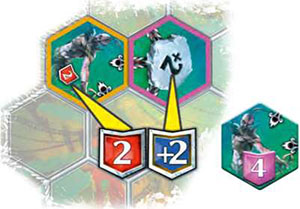
Example: If the Rune of Greater Acceleration increasing the Initiative by 2 is connected to a Champion with Initiative 2, then the marker with Initiative 4 should be placed on the Champion.
The marker should cover the Initiative value of the tile.
The marker must be removed when the tile is no longer influenced by the Rune of Acceleration (if this happens during Battle, the marker should be removed after resolving the phase in which the Rune was destroyed).
In rare cases, when the effect of the Rune of Acceleration is cumulated, the connected Champion may attack with an Initiative of 5 or higher. All such cases are marked by the player placing a 5+ Initiative marker on the tile.
When resolving Battle, the tiles with the 5+ marker attack in their respective phases in descending order, as usual (they do not all attack in a single 5+ Initiative Phase).
Rune of Regeneration
If a tile with the connected Rune of Regeneration suffers one or more Wounds from a single attack coming from a single source (one enemy Board tile, one Order tile, or from a special Feature of a single type such as Poison markers), then the Rune of Regeneration is discarded and the Wounds are ignored.
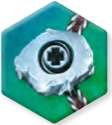
Rune of Regeneration that connects in 2 directions.
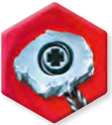
Rune of Regeneration that connects in 1 direction.
Order Tiles
Apart from Board tiles, each player has a number of special Order tiles described below. These tiles cannot be used when Battle starts, only during the owner's turn.
Order tiles are not placed on the board, but are discarded to the discard pile after use.
General Order tiles are described below. Other faction-specific Order tiles (False Orders, Precise Shot, Entrenchment, Rotation, Net) are described in detail on their respective faction reference sheets.
Battle
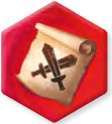
- If a player uses this tile, Battle begins.
- This tile may not be used if any of the players have drawn the last tile from their stack.
- After the Battle tile is used, the player's turn ends and he may not use any more of his tile Features.
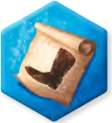
Move
This tile allows its user to move one of his tiles to an adjacent, unoccupied hex and/or turn it in any direction desired.
Fire Concoction
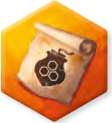
Deals 1 Wound to all tiles (excluding Banners but including your own tiles) placed in the configuration shown on the Order tile icon.
The Fire Concoction area of effect has to be completely on the board, no targeted space may be off of the board.
Example: After using Fire Concoction all 3 tiles receive I Wound and are eliminated.
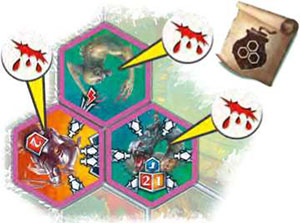
Push Back
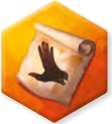
This tile allows one of your friendly tiles to push away an adjacent enemy tile, creating a distance of one hex between them.
The enemy tile can only be pushed away onto an unoccupied hex, and only a single space away.
If there is more than one unoccupied hex available, the player controlling the enemy tile decides which one to move his tile to.
The pushed back tile may not be rotated during the move.
If it is not possible to create a 1 hex space between the tiles, the Push Back cannot be used.
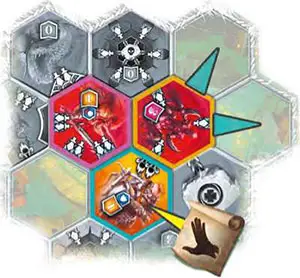
Example: A Crossbowman is surrounded by two Lords of the Abyss Champions: a Mygalomorph and a Demon. The Guardian of the Realm player decides to use his Push Back tile.
It is impossible to push the Demon away, because both hexes behind him are occupied and the only free hex is adjacent to the Crossbowman tile that will perform the push. However, it is possible to push back the Mygalomorph.
Common Problems
Using Nets
A Net disables the opponent immediately after being placed on the board (the same occurs whether you place a Champion with a Net or an enemy tile enters a Netted space).
If a Net Champion is eliminated during battle, the Net affects the other tile until the end of the current Initiative Phase, up until the Net Champion tile is removed from the board. The Netted tiles will only be able to act in the next phase, if there is one.
A tile disabled by a Net cannot move, thus it cannot be pushed away. It is possible to push back the Net Champion, releasing the netted tile from the Net effect, though this can only be done by another friendly tile, not by the tile that is being disabled.
A Net Champion can disable another Net Champion, in which case the latter is rendered unable to affect any tiles.
If two opposing Net Champions use a Net in each other's direction, they do not disable each other. In other words, two Nets aimed at each other nullify each other's function, and both Net Champions are treated as non-Netted (they can be moved normally with a Move tile).
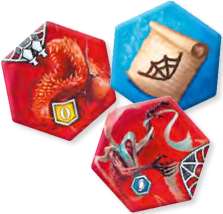
Rune of Regeneration 
A Rune of Regeneration cannot be turned off if it is connected to a tile. Its effect is continuous.
If a tile with a connected Rune of Regeneration suffers one or more Wounds from a single attack coming from a single source (one enemy Board tile, one Order tile, or from the markers of a single type, such us Poison markers), then the Rune of Regeneration is discarded and the Wounds are ignored.
If several opponents wound the target with a connected Rune of Regeneration, the player controlling the Rune decides which Wound is regenerated.If the Rune is connected to more than one tile, and all the tiles are simultaneously attacked, the player controlling the Rune chooses which one of them is regenerated by the Rune.
If both a Rune and the connected tile are hit simultaneously (in the same Initiative Phase), the Rune is destroyed first and cannot regenerate the tile.
If a single tile is connected to two Runes of Regeneration, the player controlling the Runes chooses which Rune regenerates the Wound.
If a tile is connected to a Rune of Regeneration which has another Rune of Regeneration connected to it, but the 2 Runes are not connected to each other, the Wound from an attack is absorbed by the latter Rune in the chain.
If two Runes of Regeneration are interconnected (each have the connection path turned towards the other's direction) the controlling player decides which of them absorbs the Wound.
More on Initiative 
No tile can have its Initiative reduced below a value of o. If any tile's Initiative would be lowered below o, it is treated as having an Initiative value of o.
There is no upper limit to increasing Initiative.
If a tile performs multiple hits, and has a Rune of Acceleration connected to it (increased Initiative), the bonus affects all of the attacks.
If a tile attacks in more than one direction (no matter the type of attack) and it can perform its attacks in more than one Initiative Phase (for example the Wyrm from the Harbingers of the Forest), it performs all of its attacks in each of the specified Initiative Phases.
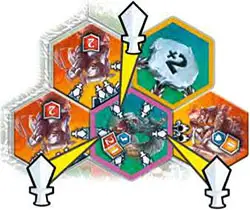
Example: The Wyrm, with a connected Rune of Greater Accelerat n, will resolve all of its attacks during Battle first in Initiative Phase 4, and again in Initiative Phase 3.
A tile can perform an attack (Melee or Ranged) only in the phase corresponding to its current Initiative. For example, a Champion with an Initiative of 3 is disabled by a Net in Initiative Phase 3.
During that phase, the Net is destroyed. Though in Initiative Phase 2 the Champion is now free, it cannot attack since its Initiative value is 3 and that phase is over.
Move 
Although tiles normally do not change their position once placed on the board, there are effects in the game that allow the player to move their Board tiles (a Banner Feature, Rune effect, Feature of the tile itself, Move Order, etc)..
There is no limit to the number of moves that you can make in your turn with one Board tile, as long as each of these moves is a result of a different action (each effect allows you to move one tile only once per turn).
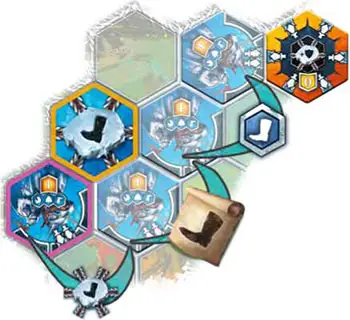
Example: The Dragon Empire player decides to use the Rune of Agility, and moves his Champion to the adjacent space. Next he plays a Move Order and moves the Knight again.
Finally he uses the Maneuver Feature ofthe Knight and moves him next to the enemy Banner, changing the direction the Knight is facing at the same time.
Continue Reading
